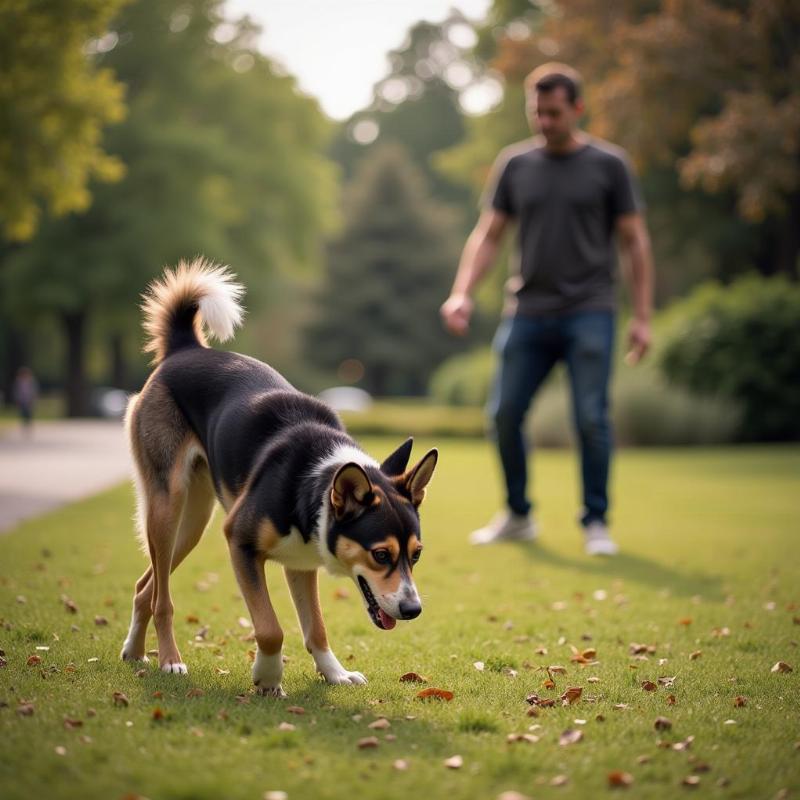When your dog’s hair stands up on their back, creating that distinctive “hackles up” look, it’s a clear sign of heightened arousal. But what exactly is causing this reaction? Understanding why your dog’s hair stands up on their back is key to interpreting their emotional state and responding appropriately. This can range from excitement and playfulness to fear, aggression, or even a medical condition. Let’s explore the various reasons behind this fascinating canine behavior.
Why Do Dogs Raise Their Hackles?
Dogs raise their hackles, also known as piloerection, as an involuntary physiological response. It’s triggered by the sympathetic nervous system, the same system responsible for the “fight or flight” response. When a dog perceives a potential threat or experiences a strong emotion, adrenaline is released, causing the tiny arrector pili muscles attached to each hair follicle to contract. This makes the hair stand on end, creating a larger, more intimidating appearance.
Decoding the Hackles: Different Meanings
While raised hackles are often associated with aggression, it’s crucial to consider the context. Here are some possible interpretations:
- Fear or Anxiety: A dog feeling threatened or nervous will often raise its hackles as a defensive mechanism. This might be accompanied by other signs of fear, such as tucked tail, widened eyes, and lip licking.
- Aggression: When a dog feels the need to defend itself or its territory, raised hackles can be a warning signal. This might be coupled with growling, snarling, and a stiff body posture.
- Excitement or Playfulness: Believe it or not, raised hackles can also indicate positive arousal. A dog might raise its hackles during energetic play or when anticipating something exciting, like a walk or a favorite toy. In these cases, the dog’s body language will be loose and playful, with a wagging tail and relaxed posture.
- Startle Response: A sudden loud noise or unexpected movement can also trigger piloerection. This is a purely reflexive reaction, and the hackles will usually go down quickly once the dog realizes there’s no threat.
 Frightened dog with raised hair
Frightened dog with raised hair
What to Do When Your Dog’s Hair Stands Up
Observe your dog’s overall body language. Is their tail wagging? Are their ears perked up? Are they growling or barking? These cues will help you determine the reason behind the raised hackles. If your dog appears fearful or aggressive, it’s best to remove them from the situation and give them space. Avoid making direct eye contact or approaching them directly, as this can be perceived as a challenge. If the behavior persists or seems excessive, consult a veterinarian or a certified dog trainer.
Medical Reasons for Raised Hackles?
Though less common, certain medical conditions can cause skin irritation or sensitivity, which may lead to piloerection. If you notice persistent raised hackles without any apparent emotional trigger, consult your veterinarian to rule out any underlying medical issues.
Understanding Your Dog’s Communication
Paying attention to your dog’s body language, including piloerection, is crucial for building a strong bond and ensuring their well-being. By understanding the various reasons why your dog’s hair raised on back of dog stands up, you can better interpret their communication and respond appropriately, creating a safer and more harmonious relationship.
Conclusion: More Than Just Fluffed Fur
The phenomenon of dogs hair stands up on back is a fascinating insight into canine communication. It’s a reminder that dogs communicate through a complex language of body signals, and understanding these signals is essential for responsible dog ownership. By recognizing the context and accompanying behaviors, you can better understand your dog’s emotional state and respond in a way that strengthens your bond and ensures their well-being.
FAQs
- Does the breed of dog affect how often their hair stands up? While all dogs can experience piloerection, some breeds with thicker coats or a predisposition to certain temperaments (like guarding breeds) might display it more visibly.
- Is it normal for a puppy’s hair to stand up frequently? Puppies are still learning to navigate the world, so their hair might stand up more often as they encounter new sights, sounds, and experiences.
- Can I train my dog to stop raising their hackles? Since piloerection is an involuntary response, you can’t directly train a dog to stop it. However, you can work on desensitization and counter-conditioning to help them feel less fearful or reactive in triggering situations.
- Should I be concerned if my dog’s hair stands up for no apparent reason? If you notice persistent piloerection without any obvious trigger, consult a veterinarian to rule out any underlying medical issues.
- What’s the difference between raised hackles and just fluffy fur? Raised hackles are distinct from simply having fluffy fur. Piloerection creates a more rigid, bristly appearance, particularly along the dog’s back and shoulders.
- Can medications affect a dog’s tendency to raise their hackles? Certain medications can influence a dog’s behavior and potentially increase or decrease their reactivity, which might affect how frequently their hair stands up.
- Is raising hackles always a sign of aggression? No. As discussed, raised hackles can indicate various emotional states, including fear, excitement, and even playfulness. Context is key to interpreting this behavior.
Related Articles:
- Why do dogs hair stand up on their back
- How to train dogs not to bark at strangers
- How to train your dog not to bark at strangers
Beautdogs.us is your premier online destination for all things dog-related in the US. We offer expert advice on dog breeds, grooming, training, health, nutrition, and much more. Whether you’re a first-time dog owner or a seasoned pro, Beautdogs.us provides reliable, comprehensive, and engaging information to enhance your canine companionship. Contact us today for personalized support. Email: [email protected], Phone: +1 501-555-7529. Learn more at Beautdogs.us.